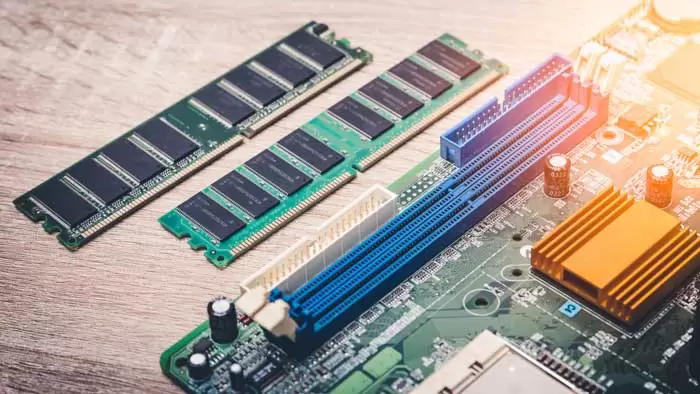How Use Hard drive as RAM (Increase Virtual RAM in Windows 10 and 11)
Windows 10 has a feature that you can use to use part of the hard drive as RAM (random access memory). RAM (RAM) is known as virtual memory, which is important for system stability and can even help improve the performance of your computer to be properly configured.
In this article, before configuring virtual Memory, we will explain how it works and why it is important.
How to Use Hard drive as RAM (Increase Virtual RAM in Windows 10 and 11)
How virtual Memory works
Virtual Memory is stored in a specific file system called a pagefile or paging file. This file is mainly used in two modes; When Windows uses all available RAM or physical Memory and when programs are inactive for a while.
The first situation is especially common in older computers with little RAM capacity. When your system’s physical memory capacity is low, the generated information has no place to store it. This is where the paging file comes into play, and Windows uses this program as physical Memory.
When programs are minimized and their data is left unused, their information can be transferred from RAM to virtual Memory to create more space for other programs and important processes. This, in turn, helps the system run smoothly and easily.
The importance of virtual Memory
Some websites recommend disabling your paging file, especially if your system has a large physical memory capacity, but this can be a bad idea.
If you do not have virtual Memory, the system will usually slow down, errors will increase, and some of your data may be accidentally lost if you overuse the computer.
This also happens if your paging file is too small. In addition, several programs and functions require active paging files to work properly.
Excessive paging file settings can also cause several problems, the most common of which is taking up too much space on your hard drive. But setting a paging file too large can also load a lot of data into virtual Memory; when you are running both compressed memory programs and a large number of simple programs when You switch between applications, they go very slowly. Virtual Memory is generally slower than physical Memory, even when stored on an SSD (solid-state drive).
Just as SSDs are compared to traditional HDDs, they can not beat RAM. If your computer is slow due to Memory, the only surefire way to speed it up is to upgrade or install a new system with high RAM capacity. However, having a high-capacity paging file also contributes to its stability and better performance. he does.
Adjust virtual memory capacity
No capacity is generally defined as the “best” value for virtual Memory, so setting a value for virtual memory capacity depends on your needs. More precisely, you can determine the capacity of your memory space based on how much RAM you have and the maximum amount of Memory you want to use or think you need.
If you have a good idea of setting a maximum for the Memory you need, the best option is to adjust your paging file so that the system memory, including your RAM, is larger than the amount you have.
For example, if you have 8 GB of RAM and have a maximum memory usage of 12 GB, you can set your paging file to 5 GB. 8 GB of RAM + 5 GB of virtual Memory = 13 GB of Memory available for the system.
Even if your maximum memory usage is based on the total RAM, it is best to set a small paging file, about 1 to 2 GB.
Task Manager test
For people who do not know how much Memory they need, there is a way to show them that they need more Memory, for example, by checking through the Performance tab submenu on the Task Manager. While pressing Ctrl + Alt + Del together is the easiest way to bring the Task Manager, there are faster methods, including:

Shortcut Ctrl + Shift + Esc
When the Task Manager is running:
1. Click on the Performance tab and then click on Memory.
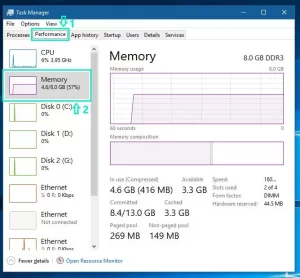
2- Open any program you want. You usually have several programs that you want to run simultaneously. Such as web browser, music player, and dictionary. Maybe a game or any other app you use normally. If running multiple programs simultaneously slows down or destabilizes your system, you may need more virtual Memory.
3. When you want to run all of these programs together, go to Task Manager and see the Committed submenu. In this part, your RAM and virtual Memory are almost combined, which shows you what is in use and what is available. If the number on the left is too close to the number on the right, it is best to increase your virtual Memory.
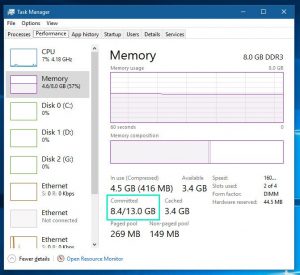
The capacity is about 2 GB more than what you currently have, a value that you can safely determine. Finally, if you need more capacity, you can increase it again.
How to set up virtual Memory
Virtual memory settings can be a bit tedious. The first step is to go to the System section in the Control Panel.
To do this, follow these steps:
1. Open the Search window by clicking on it or pressing the Win and S buttons.
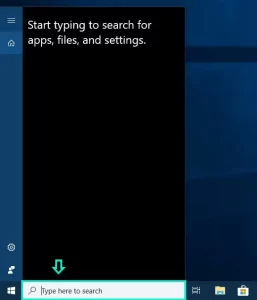
2. Start typing Control Panel. Click on it when it appears.

3. Click on System and Security
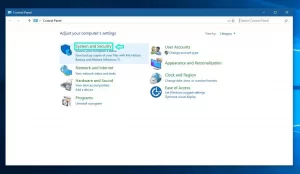
4. Click on System.
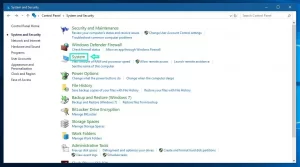
Here you can find basic information about your system, including how much RAM you have. When you go to the System page, do the following:
1. Select the Advanced system settings option on the left.
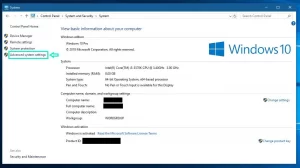
2. Go to the Advanced tab and click on Settings in the Performance section.
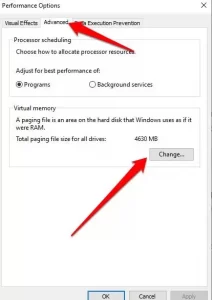
3. Select the Advanced tab and click the Change… button below Virtual Memory.

Once you go this route, you can define a value as your virtual Memory.
Doing this again depends on how much Memory you need.
In most cases, Windows itself determines the best size for its paging file, which is the best option, especially when you are unsure of the amount of Memory you need and do not want to set the correct amount manually.
Allow Windows to manage virtual Memory.
If you have only one hard drive or you do not care which paging file drives are on, it is recommended that you follow the steps below to get the best results.
1- In the Virtual Memory window, check the Automatically manage paging file size for all drives option.
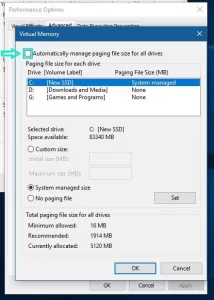
2. Click OK.
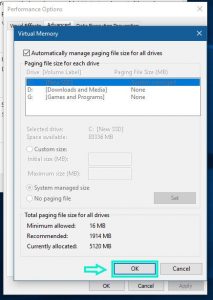
3- No,w you will receive an instant message that you need to restart to make changes in the job. Click OK.
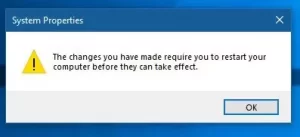
4. Click OK on all remaining open windows.

5- After that, you will receive another message about restarting the system now or later. If you want to restart immediately, you must close all open programs and click on Restart. If you do not want to restart right now, click Restart later, but be careful to restart the system as soon as possible.
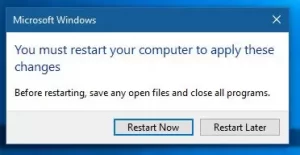
Multiple drives
For multi-drive mode, you can configure Windows to have the paging file on only one of them. If you have an SSD, assign a paging file for best performance. Lucky people with multiple SSDs can easily set up this file on one of these SSDs that does not have Windows installed. If you are worried about the life of your SSD, allocate it to an HDD. If you have multiple HDDs, you can set this file to one of those HDDs that Windows does not have installed. When done, follow these steps:
1-Ensure that the Automatically managed paging file size for all drives is not selected, then click on the drive where you want to put the paging file.
2. Click on System managed size and then on Set.
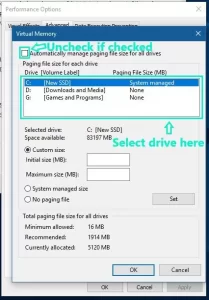
3. Select the other drives and click on No paging file. If you have not already selected it, click Set for each of them and then OK.
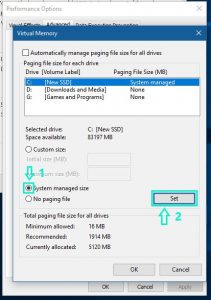
4. You will now receive an instant message as to whether you want to restart or not. Click OK.
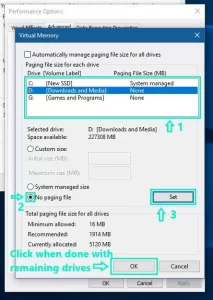
5. Click OK in the other windows again.
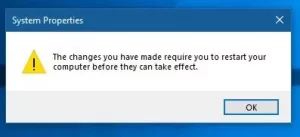
6- No,w you get a message that you want to restart right now or later. Closed all programs and click on Restart No if you are ready to restart now. If you want to restart later, click Restart Later.
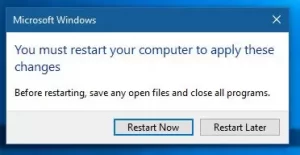
Set the virtual Memory to a fixed value
If automatic management does not help you, or your computer is already configured, manually resizing it may be the best option. In fact, with this method, you can practically adjust the amount you want from your Memory.
1- Make sure that the automatic management box is not checked, then select the drive you want. If you want, you can configure the paging file on more than one drive, but it’s good to know that there’s no point in doing that.
2. Click on Custom Size and enter the minimum size you want for the paging file in Initial size and the maximum size in Maximum size. It is good to know that 1 GB of Memory equals 1024 MB. If you do not want to resize and want exact fixed size, enter the same number in both boxes. This will help you a lot, especially when you always want to know the size of the paging file.
3- If you have several drives, select one of them each time and click on No paging file, then click Set for each of them,m and when done, click OK.
4. You will now receive a message reminding you to restart. Click OK.
5. Click OK on the remaining windows.
6- The,n you will receive the restart message again, whether you want to restart now or later. If you want to restart now, close all programs and click on Restart No; if you want to restart later, click on Restart Later. No changes will be made until you restart.
Once you’ve adjusted your virtual Memory for better performance and restarted your computer, go ahead and test it by opening the programs you did during the Task Manager test. Read this guide again if all else fails or if your Memory needs to change.
Frequently Asked Questions
Can we use internal Memory as RAM in Android?
Yes, but there is a point. It would help if you rooted your phone. Youu can not do this without a rooted phone. Suppose you have an Android device with 4 GB of RAM and 64 GB of internal storage.
Using the virtual RAM feature, part of the 64 GB storage, for example,e 2 GB, is used specifically as RAM. Currently, the total useful RAM on your device will be 6 GB (4 GB + 2 GB) with a storage space of 62 GB.
Here are some ways to root your device: You can use an external SD card to create a swap file as a virtual RAM. Note that you need a Class 10 or higher memory card to use as virtual RAM on your Android device, as follows:
- ROEHSOFT RAM Expander
- RAM Manager Pro
- Link2SD
Do we need 16 GB of RAM to play?
At the moment, 16 GB of RAM is a good amount to play. While this is not mandatory, it does help make the game run smoother, especially if you want to run a game with all the detail and high resolution; otherwise,e 8 GB of RAM for most of the games ever released. Hav, enough.
Conclusion
In this article, you learned how to use your storage as RAM in Windows 10, Windows 1,1 and even beyond on a rooted Android phone. You also learned why RAM is so important, as it stores your essential information so that it can be accessed quickly when needed. So you want to learn more than that? So feel free to browse the rest of our content and read more articles and information about Windows and PCs.
